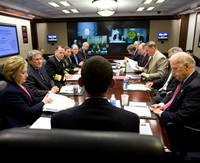In U.S. domestic politics, which demands that presidential administrations pursue policies with near-instantaneous results, the biblical adage, "One sows, another reaps," is anathema. As a result, President Barack Obama is not only under growing pressure to demonstrate results to a skeptical American electorate months before the 2010 midterm elections, he also needs to chalk up a series of successes to buoy his 2012 re-election campaign.
Fortunately, as Secretary of State Hillary Clinton pithily noted during her last visit to Georgia, the United States is able to walk and chew gum at the same time. This logic also applies to the administration, which should be able to focus both on dealing with the immediate crises of the day, while engaging in some longer-term planning to secure America's position as a global leader. In any event, this was the subject of Clinton's major foreign policy address this week in Washington, in which she noted that U.S. policy aims to"reinvigorate America's commitment to be an active trans-Atlantic, trans-Pacific and hemispheric leader."
But while the secretary hit all the right notes, we still lack the roadmap laying out how to build up these partnerships over time. This is, after all, going to require a multi-administrational approach, even assuming that Obama is returned to the White House for a second term.

